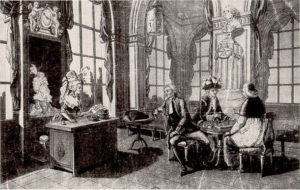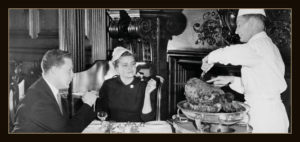There are two polls. Feel free to answer one or both or write your own in the comments.
For either poll, please imagine the love interest of your choice.
Heroine
Hero
There are two polls. Feel free to answer one or both or write your own in the comments.
For either poll, please imagine the love interest of your choice.
Have you been out to dinner at a nice restaurant lately? When you told your friends, did they look at you with pity and then gossip about you behind your back? Is your reputation ruined? How times change, LOL!
The fact is, during the Regency in England, dining out as a social event the way we know it was not done. The very concept of the modern restaurant was still in its infancy –it evolved in France (of course?) in the later 18th century and had not successfully caught on yet in England. But there was a glimmer on the horizon, and a few eating establishments were heading in the right direction. (I’ll come back to these near the end.)
People did “eat out”, of course. You could obtain a meal in a tavern, pub, or an inn or a fine hotel, particularly if you were traveling. You could purchase specific foodstuffs from street vendors, but that wasn’t a “meal.” And any of these were, in general, patronized out of necessity or convenience, not for pleasure. There were no menus offering choices –only perhaps, a list of what was to be served. Generally only the simplest inexpensive meats and vegetables were served, except for a few taverns that catered to a specific well-heeled (male) clientele.
If you were an upper-class male, you could enjoy a meal at your private club. The food offerings might be somewhat more elegant, but would still be limited. You ate what they served, at the time they served it. Men could also patronize the coffee and oyster houses, which often served other food in addition to their main focus. For females to dine in public was quite shocking, however, unless in a coaching inn, and if you were of the upper class, you would still insist on a private parlor.
Part of the stigma, of course, came from the fact that acceptable households employed their own cooks. Why would you prefer to eat out when you could eat in? “Dining out” socially meant going to dinner at someone else’s private home, eating food prepared by their cook instead of yours.
Another part of the stigma was the idea of rubbing elbows with the hoi polloi –the general public. Not done! People forced to “eat out” were the poor who had no cook, and often, no kitchen at all. Taverns were noisy and crowded, with communal tables. “Even a moderately well-to-do person would have preferred to order food delivered to a private home or a room at an inn or hotel or an elegant salon rented for the occasion…” (1)
No wonder your friends viewed you with pity! What calamity caused you to need to eat out? And if you were female in mixed company, oh, dear. Shocking!
These social aspects of dining out offer a clue to why the modern restaurant was born in France (and why England resisted). The French Revolution brought in sweeping social changes that coincided with some new developments. “Restaurant” originally meant a type of meat soup, like consommé or bouillion, used medicinally as a “restorative”. In 1765 a bouillion-seller had opened a shop with tables where ailing customers could sit and eat their soup. Different customers required different types of restoratives, so the idea of individual customized servings was introduced. Others copied the idea. In the early 1780’s a man named Beauvilliers, the former chef of the Count of Provence, carried the conceit further and opened the first real restaurant with small individual tables and a menu listing individual choices with prices.
In 1786 he opened the first “luxury” restaurant in the Palais Royale, featuring mahogany tables with white tablecloths, trained waiters, chandeliers, a wine list and an extensive menu of fine food choices. That same year, the Provost of Paris issued a proclamation officially recognizing and authorizing these new types of establishments. These developments paired with a ready supply of cooks and servants no longer employed by the artistocracy, the dissolution of the guilds that had restricted how and by whom food could be prepared, and a customer base of displaced provincials without families in Paris, journalists and businessmen, a newly important middle class. Two different principles were suddenly wedded in a successful new way to do business –the personal tastes, budget and choices of the individual now controlled the purchase of a meal, while the egalitarian social climate celebrated that “Eating [well] was no longer the privilege of the wealthy who could afford to maintain a cook and a well-supplied kitchen.” (2)
 Within ten years there were more than half a dozen restaurants in Paris, and “dining out” was accepted practice there enough to provide the basis for a political cartoon about the 3rd Estate in France (above), entitled “Separate cheques please”:
Within ten years there were more than half a dozen restaurants in Paris, and “dining out” was accepted practice there enough to provide the basis for a political cartoon about the 3rd Estate in France (above), entitled “Separate cheques please”:
Meanwhile, back in London, the oldest still-surviving restaurant in London, Rules, was started in 1798, on Maiden Lane in Covent Garden. Although at first it was simply an oyster bar, as their website states: “Contemporary writers were soon singing the praises of Rules’ “porter, pies and oysters”, and remarking on the “rakes, dandies and superior intelligence’s who comprise its clientele”.
Two other London establishments might challenge the “oldest” claim by Rules, but one (Wilton’s, opened 1742 as a seafood street stall, 1805 as an oyster room) has changed locations and nature many times, while the other (Simpson’s Tavern) is more of a pub, and ancient pubs are not rare anywhere in England! Note ladies were not admitted to Simpson’s Tavern until 1916.
Simpson’s-in-the-Strand (not related) was founded in 1828 primarily as a chess club/coffee house/smoking room (“The Grand Cigar Divan”). They are still famous for serving meats at tableside from antique, silver-domed carving trolleys, a practice said to have evolved to avoid interrupting the play during chess games. 
You can see these were not yet exactly “restaurants” in the Parisian sense at the time they opened their doors. The modern form of “dining out” really didn’t take hold in Britain until the mid-Victorian era, when the swelling ranks of the new middle class provided an enthusiastic customer base for it.
Have you written or read characters who needed to dine out for one reason or another? Are you surprised to know what a big difference existed between customs in Paris and London during this time period? Have you ever eaten at any of the London restaurants mentioned, or have a favorite restaurant there to share?
Sources quoted:
(1) “The Rise of the Restaurant,” Food: a Culinary History, Jean-Louis Flandrin & Massimo Montanari
(2) Oxford Companion to Food, Alan Davidson [Oxford University Press:Oxford] 1999)
For further reading online:
http://www.foodtimeline.org/restaurants.html#oldestmenu
https://www.mtholyoke.edu/courses/rschwart/hist255-s01/pleasure/history_restaurant.html
Also, check out:
A History of Cooks and Cooking, Michael Symons [Universtiy of Illinois Press:Urbana IL] 1998 (p. 289-293)
Save

Last month I re-released Castle of the Wolf, a novel that was originally published back in 2007. It is a gothic romance — well, at least, it was planned as one, only then the lady with the sturdy boots turned up in the story and stomped all the gothicness to dust. Quite… eh… literally.
In the best gothic tradition, Castle isn’t set in England, but in southern Germany — in the Black Forest, to be exact, the place where I spent my primary school years and a place that is drenched in stories and covered with deep, dark woods. And quite a few castle (ruins).

The Kastelburg in Waldkirch. I spent my primary school years in this little town, & the town & castle were the inspiration for the main setting in Castle of the Wolf
Upon her father’s death, my heroine surprisingly inherits one such castle upon the condition that she marry the son of its former owner. Alas, that son turns out to be a super-grumpy dude, who does his very best to make Cissy leave the castle again. Enter rats, bats, a mouse skeleton (hey, it’s a gothic romance, there needs to be a skeleton, right?), and a bunch of very mysterious gargoyles. Oh, and there’s a very intriguing deck of (erotic transformation) cards too. In other words, my heroine has her work cut out for her if she wants to unravel the secrets of the castle.
One of the main themes of the novel is hinted at when Cissy is still in England and is packing her bags:
Cissy carefully wrapped one of her tea dresses around her copy of the Lyrical Ballads so the leather-bound volume would come to no harm in the travel chest during her journey. […]
“I cannot imagine what you want to do in Baden.” Wood creaked as her brother George shifted on the chair. “There is nothing for you there.”
There is nothing for me here. For a moment, Cissy had to close her eyes. Then she shook her head and busied herself with wrapping her book and putting it away. “I am going to have a castle.” Just imagine: a castle. Like a princess. She took up another tome.
“And marry a man you have never seen in your life.” Suddenly George sounded aggressive. “How our dear father could have come up with such a harebrained scheme is quite beyond me, I swear!”
Distracted, Cissy frowned and rubbed a thumb over a scratch in the blue leather cover of her book of German fairy tales, a present from her father for her nineteenth birthday. With her forefinger she traced the golden lettering: Kinder- und Hausmärchen gesammelt durch die Brüder Grimm.
Castle of the Wolf is a story about stories: it’s stuffed full of references to fairy tales, local legends, and to modern popular literature. While Cissy travels to the Black Forest by steamboat down the Rhine, she hears the grizly legend of the Mouse Tower of Bingen (evil bishop eaten up by mice), and later on Fenris, the grumpy hero, provides for a nice Austen / Bridget Jones moment: “For somebody called Fenris to strut around like a snarling demon wolf was just as ridiculous as, say, for somebody called Darcy to refuse to dance at an assembly.” I also couldn’t resist putting a German copy of Terry Pratchett’s Men at Arms (Helle Barden) into the castle library.
However, the most significant body of reference is formed by works of British and German Romanticism. I mean, when you have a grumpy hero and a completely exasperated heroine, you just have to reference Byron’s Byronic heroes, right? (Or rather, let the heroine reference them.) (She has never liked Byron’s Pirate and thinks Fenris’ sulking around the castle is a tad too melodramtic.) In addition, the German setting allowed me to refer to all my favorite German literary fairy tales, first and foremost Ludwig Tieck’s “Eckbert the Fair” (no happy ending, alas) with the enchanting song about woodsolitude sung by a magical bird:
Wooldsolitude,
Brings joy to me
Now and tomorrow
Forevermore,
What joy to me,
Woodsolitude.
In the course of Castle of the Wolf, Cissy also reads one of my favorite literary novels in German, E.T.A. Hoffmann’s The Life and Opinions of the Tomcat Murr. The first two volumes of the novel were published in 1819 and 20; Hoffmann died before he could begin working on the third volume. In a way, it is fitting the novel remained a fragment, for it is told in fragments: it is the autobiography of the (rather conceited) Tomcat Murr, who rips apart an older book to have paper to write on and as blotting paper. This older book is another biography, that of the bandmaster Kreisler, and at first it seems that these two stories don’t have anything to do with each other, but they become more and more intertwined. The Life and Opinions of the Tomcat Murr was clearly a writing experiment for Hoffmann, a fun project where he created something very innovative and very intriguing.
 So in other words, my own novel, Castle of the Wolf, is a declaration of love for stories and for reading and for seeing the world through the lens of fiction.
So in other words, my own novel, Castle of the Wolf, is a declaration of love for stories and for reading and for seeing the world through the lens of fiction.
If you would like to accompany Cissy on her journey to the Black Forest, grab a copy of Castle at the following retailers:
Amazon: http://www.amazon.com/dp/B01IDD8K7U/
Apple: https://itunes.apple.com/us/book/id1133885806
B&N: http://www.barnesandnoble.com/s/2940153356716
Kobo: http://store.kobobooks.com/Search/Query?fcmedia=Book&query=9783000400926
Happy reading!
I am just finishing up the fourth book in my Scandalous Summerfields series today, Lorene’s story. As befitting the title of the series, scandal plays and important role. Lorene has an abhorrence of scandal, but it does seem to follow her wherever she goes.
 The was not the first time I’ve written about scandal so today I’m reprising a blog I wrote on the subject in 2008. Scandalizing the Ton, one of my books that came out that year, was what I called my “Regency Paparazzi” story. It was inspired by our present day obsession with celebrities, but we didn’t invent an interest in the rich and famous. Nor did we invent a press willing to do almost anything for some good gossip about them.
The was not the first time I’ve written about scandal so today I’m reprising a blog I wrote on the subject in 2008. Scandalizing the Ton, one of my books that came out that year, was what I called my “Regency Paparazzi” story. It was inspired by our present day obsession with celebrities, but we didn’t invent an interest in the rich and famous. Nor did we invent a press willing to do almost anything for some good gossip about them.
The eighteenth and nineteenth centuries abounded with newspapers. Some of them even reported important news, like what was happening in Parliament, social issues, important events. It was during this period that some of journalism’s standards and ethics were beginning to be established, things like not revealing sources, acting as society’s social conscience, which was not always a good idea.
 James Leigh Hunt and his brother, John, published serious news in their London newspaper, The Examiner, including calling the government to task for the heavy taxes levied on the people. In 1812, they printed an article criticizing the Prince Regent for his gambling and womanizing and running up huge debts while not doing anything to better the lives of the citizenry. Although what they printed was true, the Hunts were sued for libel and imprisoned for two years. Leigh Hunt continued to edit The Examiner from his prison cell.
James Leigh Hunt and his brother, John, published serious news in their London newspaper, The Examiner, including calling the government to task for the heavy taxes levied on the people. In 1812, they printed an article criticizing the Prince Regent for his gambling and womanizing and running up huge debts while not doing anything to better the lives of the citizenry. Although what they printed was true, the Hunts were sued for libel and imprisoned for two years. Leigh Hunt continued to edit The Examiner from his prison cell.
 In contrast to the responsible and ethical journalism of the Hunts were the newspapers that flourished by reporting the scandals and peccadilloes of the wealthy, the political elite, and the aristocracy. In his wonderful book, Scandal: A Scurrilous History of Gossip, Roger Wilkes gives examples of the eighteenth and nineteenth century love of gossip, and how the newspaper reporters purchased the juicy tidbits from loose-lipped servants and gentlemen and ladies willing to expose their friends. Not only did newspapers purchase gossip, they also blackmailed their potential victims, taking money to not print some embarrassing incident.
In contrast to the responsible and ethical journalism of the Hunts were the newspapers that flourished by reporting the scandals and peccadilloes of the wealthy, the political elite, and the aristocracy. In his wonderful book, Scandal: A Scurrilous History of Gossip, Roger Wilkes gives examples of the eighteenth and nineteenth century love of gossip, and how the newspaper reporters purchased the juicy tidbits from loose-lipped servants and gentlemen and ladies willing to expose their friends. Not only did newspapers purchase gossip, they also blackmailed their potential victims, taking money to not print some embarrassing incident.
They also just made up stories. In Punch Thackeray and his colleague Jerrod parodied that sort of newspaper with their creation of the reporter, Jenkins, who rarely left his humble abode, preferring to invent his stories about the latest shocking antics of important people.
 In my opinion the worst of them all was Theodore Hook, a charming and pleasing fellow who came into the Regent’s favor as a very young man, winning a government job at the ocean paradise of Mauritius. Hook lived an idyllic life for four years until a clerk embezzled lots of money that was Hook’s responsibility. He returned to London under a cloud and, in 1820, to make back the income he lost with his government job he started the Sunday newspaper, The John Bull.
In my opinion the worst of them all was Theodore Hook, a charming and pleasing fellow who came into the Regent’s favor as a very young man, winning a government job at the ocean paradise of Mauritius. Hook lived an idyllic life for four years until a clerk embezzled lots of money that was Hook’s responsibility. He returned to London under a cloud and, in 1820, to make back the income he lost with his government job he started the Sunday newspaper, The John Bull.
Unlike the Hunt brothers, Hook allied himself with the Prince Regent and whipped up scandal and gossip about prominent Whigs. Favorite targets included The Regent’s estranged wife Queen Caroline and the ladies who attended her. One he branded as ‘strangely susceptible to the charms of her own sex’ ; another he accused of having “criminal affection” for a menial servant (Wilkes, 2002).
Hook had no qualms about paying servants to betray their employers, but most of what he learned was through his own ears. Hook succeeded in keeping it secret that he was the editor of The John Bull. Because he was well-connected enough to move in high circles, he dug his dirt in anonymity, from the very people who extended him their hospitality. Such inside information had huge appeal and the newspaper flourished.
In this secret position of power, Hook mercilessly pilloried those who crossed him. When suspicion grew that he was the editor of the Bull, Hook even wrote a letter to the editor (himself), protesting that he was not the editor. He was a known prankster. In his most famous prank, The Berners Street Hoax, he wrote 4000 letters calling for tradesmen, delivery men, professional men such as physicians and dentists, potential empoyers, wig-makers, dressmakers, members of Parliament and of the aristocracy, all to descend upon the house of an innocent middle-class woman, Mrs. Tottenham. While the street became clogged with people, Hook and his friend stood by and laughed. All I can think of is what a cruelty this was to all those people who were only going about their ordinary lives. He cost them all time and money and dignity.
When Queen Caroline died The John Bull turned to more serious journalism. Eventually Hook was made to pay for the embezzlement, a huge amount that took all his assets and landed him in debtor’s prison for two years. After prison he turned to writing novels, none of which were particularly distinguished. He continued his high living until his liver gave out and he died at age 53.
In Lorene’s story there isn’t any journalist quite as reprehensible as Theodore Hook, but the shady tactics and irresponsible journalism of the Regency are depicted once again, as I depicted them in Scandalizing the Ton.
The next book in the Scandalous Summerfields series is Genna’s story, Bound By One Scandalous Secret. Watch my website for more news about this new release, coming in print form November 22 and ebook December 1! The cover should be coming soon.
Who else is finishing a book? Are you writing it or reading it? Or both?
Thanks to Scandal: A Scurillous History of Gossip by Roger Wilkes, Atlantic Books, 2002, for most of this information
A retreat. Sylvan peace and lots of writing.
Sort of. That’s what I was doing last week, at a writers’ retreat in NC (and I have to say it, but the south is weird. Just weird. Sorry, y’all. But that’s not what this post is about).
 There were trees. Lots of trees. Mountains. Fresh air. And at 3000′ you don’t need AC. It was incredibly quiet, too. I consider that I live in a quiet place although there is a constant hum of traffic, and on the weekends a lot of screechy power tools as neighbors beautify their surroundings. We even have more birds here. The dawn chorus up in the mountains was fairly restrained.
There were trees. Lots of trees. Mountains. Fresh air. And at 3000′ you don’t need AC. It was incredibly quiet, too. I consider that I live in a quiet place although there is a constant hum of traffic, and on the weekends a lot of screechy power tools as neighbors beautify their surroundings. We even have more birds here. The dawn chorus up in the mountains was fairly restrained.
 Lovely sunsets and spectacular storms. This pic captures both.
Lovely sunsets and spectacular storms. This pic captures both.
Also lots of wildlife. We were told not to hike the trails alone because there had been bear sightings, although I’m not sure if anyone had told the bears not to come onto the tarmac. We didn’t see any. I saw deer and wild turkeys that did not stand still long enough for me to take their pics, altho this sleeping beauty, a lunar  moth, allowed itself to be photographed. It was quite big. There is nothing to indicate scale here except that it is on a window sill. Now if that was a piano keyboard in the background it would be a truly monster moth.
moth, allowed itself to be photographed. It was quite big. There is nothing to indicate scale here except that it is on a window sill. Now if that was a piano keyboard in the background it would be a truly monster moth.
The other wildlife was the writers, a friendly bunch who liked to party. I’d post the pic of the pirate party but inexplicably it’s upside down. Just imagine.
This wasn’t a romance writers event and so there were no editors or agents and it was a time for people to write, critique, and talk about writing. There were also readings, again generally a non-romance thing. I had some notoriety as someone who wrote filthy stuff and considered reading a spanking scene aloud until I realized that to do so I would have to use three different dialogue voices, and decided against it.
So was it worth it? Definitely, yes. Do you really need to get away into a different environment with minimal internet and (mostly) no phone to crank up your writing? I’m undecided. If I wanted to lock myself up and write write write this wasn’t the place to do so, since there were classes to attend or audit. (I chickened out midway through the week and drove to the nearest Burger King to read my emails.) But it was a good place to take a breath and plan what to do, and where my writing should go next.
Have you been on a retreat? Did you find it useful?
